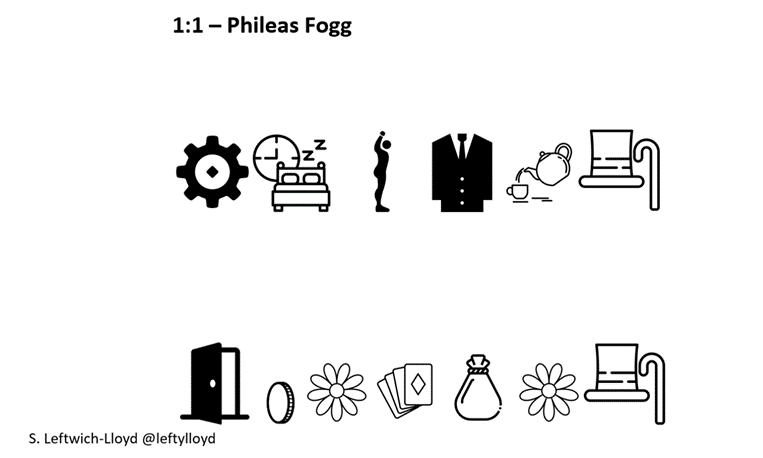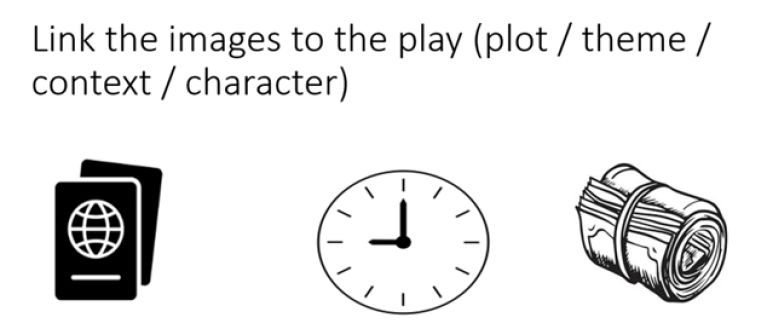This blog is based on an article first published in “National Drama” magazine.
Introduction - My Journey
I have been using ‘dual coding’ in my teaching for many years; I knew that images and diagrams added clarity when I was teaching, and that they helped students to learn concepts and specific information more quickly.
Three years ago, I attended a session by Oliver Caviglioli at ResearchED and was introduced to his work explaining the science behind these concepts and presenting potential tools for teachers to improve their use of dual coding. I purchased his book ‘Dual Coding with Teachers’ and, guided by clearly explained principles supported by research, I have significantly developed how I create and use teaching presentations and educational resources. This article aims to give a glimpse into how the theory can be brought into my Drama classroom.
What is Dual Coding?
In its simplest form, dual coding is using images and / or graphical representation alongside text or verbal instruction to make information clearer and therefore more accessible. Linking images to key theories, concepts and ideas enables students to quickly recognise and connect material. Images summarising key messages in text can draw attention to central meaning more successfully than headings and skimming. Using dual coding theory to create and design the layout of worksheets, PowerPoints and displays makes them easier to access, read, understand and learn from
A (very short) Summary of the Research - Learning and Dual Coding
We learn by building schemas in our mind: models which organise our learning in a logical way. Think about the way that books are arranged in a library – within their genre, then alphabetically; within the book there are chapters which follow on, then sentences and words. The contents of our long term memory are “sophisticated structures that permit us to perceive, think, and solve problems,” (John Sweller in Exploring your mind, 2020) rather than a group of rote learned facts. If, for example, I asked you to name as many animals as you could, it is likely that you would think of one and then list related animals (farm, zoo, pet, safari etc) before going on to another category. This is because the information is arranged logically in your mind. Our schemas are dynamic - they are constantly shifting to accommodate and assimilate new information. Teachers need to understand this to ensure that we build these structures in a logical sequence and that we activate prior knowledge when presenting new learning.
In his book, Caviglioli (2019) explains Allan Paivio’s theory from the 1970s that people process visual and verbal information separately and simultaneously therefore providing both together can boost learning and retention. Caviglioli explains how the two inputs trigger different parts of the brain meaning that, “people learn better from graphics and words than from words alone.” (Richard Mayer in Caviglioli, 2022). It is this concept which we can then use to support and ease learning.
Caviglioli states the benefits:
- Direct attention
- Trigger prior knowledge
- Manage cognitive load
- Build schema
- Transfer to working memory
- Motivate (2019:40)
Practical Applications for GCSE Drama
Command Words
I teach AQA GCSE Drama offering acting and design ‘pathways through the qualification’. Early in the course, I explicitly teach the command words which students will encounter. I utilise icons to teach key skills like ‘description’, ‘analysis’ and ‘evaluation’ which are used as command words in examination questions and NEA tasks. For example, when I teach how to evaluate, which is defined as “make a judgment from the evidence available” (AQA, 2023), I ask students to focus on three key elements to ensure a range of rich, diverse evaluative comments rather than them duplicating similar comments. I offer them triads of icons to trigger my definitions, for example, evaluate equals:

2. Achievement of aims;
3. Audience / personal response
I accompany this with key vocabulary and sentence structures; we practise the recall and linking of the word ‘evaluate’ to these three images to create a mental model of what the word means. Students create their own version in their exercise book which they elaborate and then reduce. Over time, this becomes automatic and their evaluations, in turn, improve.
Many years ago, I created a framework called ‘The Drama Sixes’, it is six key elements for each area of drama: acting, set, costume, props, puppets, lighting and sound to support ‘description’ and ‘designing’. The repetition of the grid structure and similarities between some of the design elements, support students in creating a mental framework to think through when planning practical application or answering examination questions. I always use the same icons to reduce cognitive load and regularly present ‘icon only’ grids to support retrieval exercises. The AQA specification utilises the command “describe” defined as “set out the characteristics of something” (AQA, 2023) in multiple contexts. I have found that students struggle to reliably describe the range of their ideas and tend to rely on one key element which they repeat over and over, for example, by quoting a line and then describing the character’s voice.
My creation of the ‘drama sixes’ gives students the range of characteristics and the use of a familiar structure provides a ‘mental model’ for them when thinking and a check list for examination writing. For example, here is my ‘costume six’:
I use these in both practical and theoretical elements of the course as a planning, thinking and writing structure. I use these framework to add additional scaffolding for specific tasks. For example, to support detailed description for the acting questions based on set texts and live theatre reviews, I created a more detailed version which uses the icons and layout which students are already familiar with to reduce their cognitive load but added three prompts for each element instructing students to use it as a frame to construct their sentences. This one is for acting:
This supports students in ensuring sufficient detail in their practical examples to access upper mark bands. My golden rule is to describe three skills and to include three elements of each.
Plot and Theme
When I begin teaching a set text, I always align my theory lessons with practical. We start reading the play in theory annotating challenging tier 2 and 3 vocabulary, colour-coding set / sound / lighting / costume references and gaining an understanding of the plot and characters. This enables practical lessons to focus immediately and quickly on practical realisation and develops students’ annotations as their knowledge and understanding progress.
I always use icons when teaching vocabulary creating a simple PowerPoint which I can display as we read. Each slide offers an icon, simplified definition and contextualisation in a sentence. Key and repeated vocabulary may sometimes include etymology where this will assist with word understanding, for example, a Purser originally looked after the money or the purse which demystifies this unfamiliar word. The icon quickly activates prior knowledge and gives a sense of the word which helps students to assimilate the word into their schema before exploring it in the lesson. Here is an example from ‘Around the World in 80 Days’, our chosen set text:
To develop understanding of plot and themes, I created a booklet representing the whole play as a series of icons. Whilst this was initially time consuming, the huge range of uses made the time investment worthwhile. I use this booklet for multiple purposes:
- Before reading a scene: we look at the icons and explore what we expect to happen / links to previous events (icons they have seen before) and any patterns.
- Retrieval: after reading a scene, I ask students to use the icons to:
- tell the story to their partner (sounding a buzzer every 30 seconds so that they swop);
- individually annotate the story beneath;
- shuffle the icons and ask students to put them in the correct order.
- Analysis: when preparing to answer a question on a particular scene, I ask them to revisit the graphical representation to enable them to quickly skim the plot.
Here is an example from scene 1 of Laura Eason’s ‘Around the World in 80 Days’ (AQA GCSE Drama set text). This representation makes Fogg’s strict, repeated routine in the opening scene exceptionally clear:

I use single icons from the full plot to develop students’ ability to make connections in retrieval activities. At the start of a lesson, I display three icons on the board and give a set amount of time to make as many associations and connections as possible. For example (again from ‘Around the World in 80 days’):

These three images are critical to the play and can therefore act as a trigger to activate their knowledge but then to make links which they hadn’t seen before. For example:
- Passport – Fogg is travelling; he has to have his passport stamped in every country to win the wager; it is because he is having his passport stamped that Fix sees his money and then follows him …
Dual Coding Top Tips
My top tips for utilising icons are:
- Reuse the same icons each time you revisit the material to help students to make direct and immediate associations.
- Place icons near large paragraphs of text or new words to help students to focus on the main point.
- Add icons to Powerpoints, worksheets and displays to reduce the ‘clutter’ and enable students to quickly understand the focus and find information
- Use icons as a thinking / writing structure to reduce cognitive load.
References
AQA (2023) Command Words [available online] https://www.aqa.org.uk/resources/drama-and-performing-arts/gcse/drama/teach/command-words (accessed 30/05//2023)
Caviglioli, O (2022) Olicav [available online] https://www.olicav.com/ (accessed, 15/10/22)
Caviglioli, O (2019) Dual Coding with Teachers, John Catt
Caviglioli, O & Goodwin, D (2021) Organise Ideas, John Catt
Eason, L (2015) Around the World in 80 Days, NHB
Exploring your mind (2020) John Sweller’s Cognitive Load Theory [available online] https://exploringyourmind.com/john-swellers-cognitive-load-theory/ (accessed 15/10/22)
Noun Project (2022) The Noun Project [available online] https://thenounproject.com/ (accessed, 15/10/22)
Wertenbaker, T (1995) Our Country’s Good, Bloomsbury

Sharon Leftwich-Lloyd (@leftylloyd) is Lead Practitioner and Drama Lead at The Polesworth School, Warwickshire and also leader of the Community Academies Trust Expert Group for Secondary Literacy, Reading and Numeracy. She favours a research / evidence led approach to teaching and is a Fellow of The Chartered College of Teaching.


